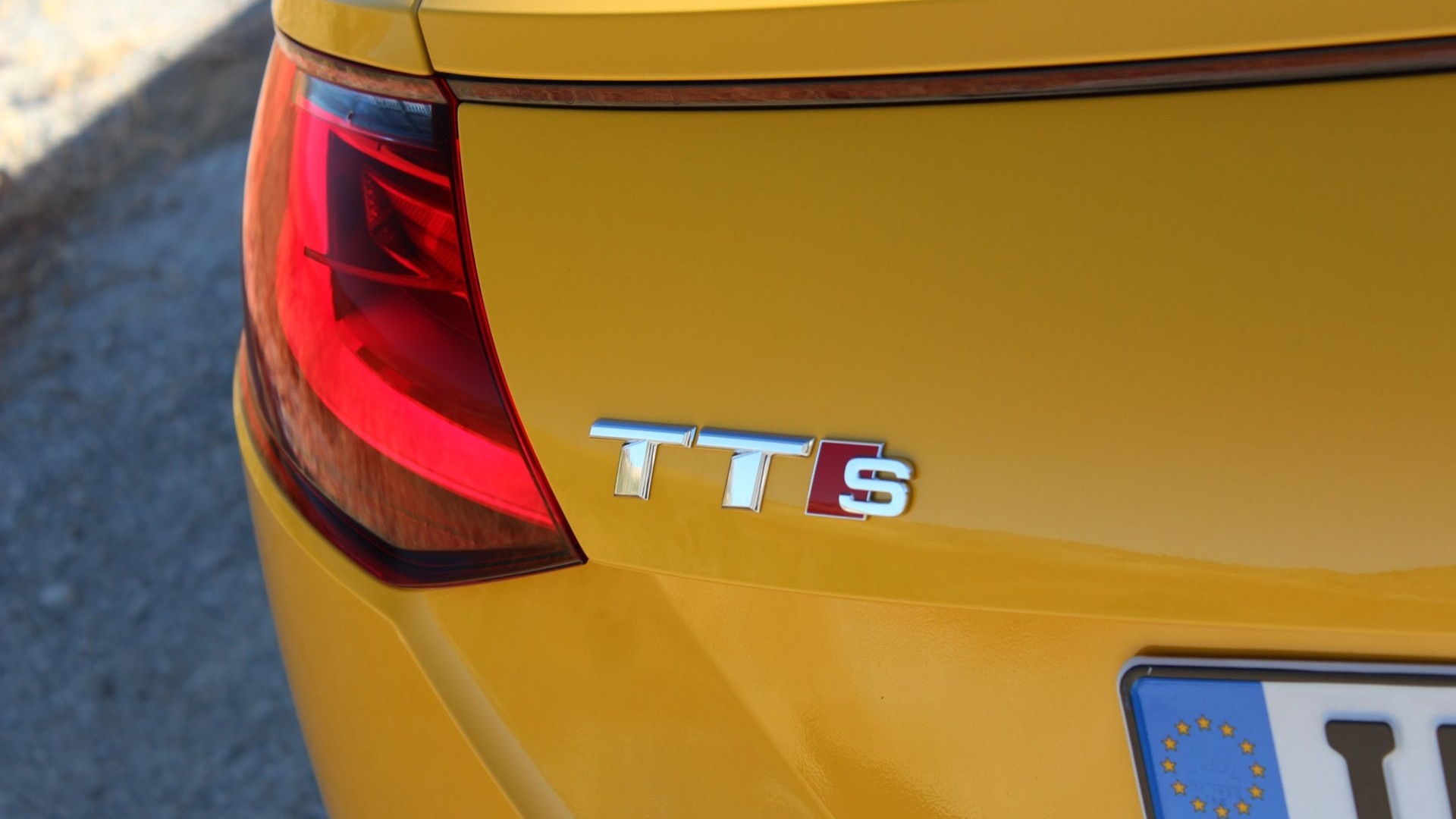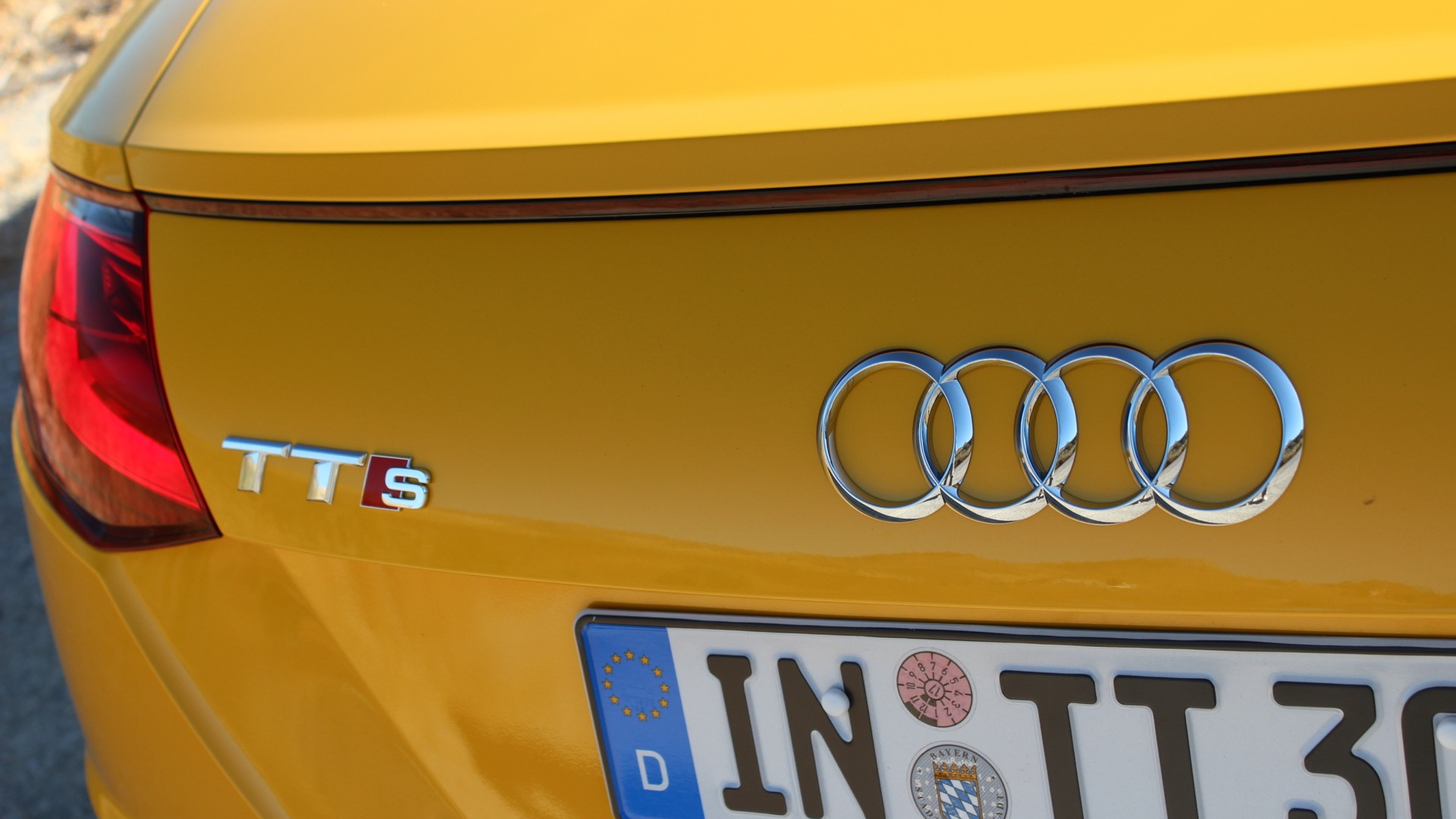The task automakers face when they have to update established sporty coupes or roadsters, like the Audi TT, is nothing to be envied. As much as we like seeing the result, it calls for a series of tough decisions: Do you evolve the design, the technology, and the driving experience, as you usually would a sedan or crossover, or do you transform it for a new era?
The 2016 Audi TT and TTS, as we noted in an early preview drive this past week in Spain, seem to take both routes. For this redesigned third-generation TT, which arrives in the U.S. late next summer (but was presented in essentially the same form as we'll see it), the exterior design and packaging feel almost obsessively restrained, carrying over the look and layout of the current car to the degree that some non-TT owners might not even recognize the 2016 model as completely new. On the other hand, the dash layout and cabin tech are radically transformed—ushering a different driver-centric, cockpit-like design and futuristic layout that headlines all impressions once you're inside.
MUST SEE: First Lamborghini Huracán Crash Results In Nothing But Ashes
And the driving experience itself? It's as if you can feel this push and pull between conservative and daring in the way the new TT drives—as it's light and lean in a way the outgoing car never was, yet its performance improvements are incremental.
Skipping past that exterior—it's a little more taut and athletic, with the front and rear a little more 'chopped off,' and gets some R8-influenced details in front and in back, like the sharper LED matrix headlight detail and single-frame grille—the interior is indeed a revelation. Instead of the conventional dash that's split between the driver and passenger, with a center stack of controls in between, the entire dash feels race-inspired and cockpit-like, with a central display in front of the driver and the dash itself swept back, minimalist-style, like an aircraft wing, adorned below with big, circular climate-control vents that you can almost imagine as engines hanging off that wing. Each of those circular vents twists to control flow, presses for climate settings, and houses digital displays for temperature and fan.
If you don't think that's radical enough, there's the gauge display itself. All TT models get the Audi virtual cockpit, with a 12.3-inch display instead of gauges. It's essentially one super-wide-screen (1440 x 540) display, with colorful, super-high-contrast sharpness. And while it's not a touch screen (that would be silly to reach through the steering wheel, wouldn't it?), you can click through two different core gauge views—or a third in TT models with a large tachometer and a digital speedo in the middle.
DON'T MISS: Watch The Tesla Model S-Based Saleen Foursixteen Burn Rubber: Video
A virtual cockpit for the driver—not the passenger
In theory the setup makes good sense. You can control the system from a low center-console controller, much as in Audi's other models, or with expanded voice controls, or even with an MMI touch scratch pad that has a predictive search feature, letting you trace out characters to quickly select anticipated contacts or destinations. A left toggle on the steering wheel gets to root menu choices, while a right toggle navigates through case-dependent choices. Even in its 'navigation plus' form, MMI now has only six physical buttons.
We like it, but have some reservations about a few things. For instance, if you're following navigation directions, the scrolling of the map can be tough to follow on such a narrow, wide screen; and then there are all the issues with a passenger who wants to help you follow those directions, or help play DJ while you drive. Although the core intent is solid, the layout isn't for everyone.
But the way the TT drives is quite universally appealing. With power of the 2.0-liter turbocharged, direct-injected four-cylinder now up to 230 horsepower and 273 pound-feet, the base TT offers some pretty satisfying performance—0-60 mph in just 5.3 seconds. We also drove the TTS, which steps up a lot in horsepower (to 310) and only slightly in torque (to 280 lb-ft)—factoring to a 0-60 mph time of just 4.6 seconds. Comparing the two, in all honesty, the TT feels nearly as quick in real-world, public-road situations, while high-revving out on a racetrack you can harness the added gusto of the TTS engine. The star with either engine (and the only transmission for the U.S. this time) is the S-tronic dual-clutch (DSG) automatic, which never seems to skip a beat and smacks eagerly into the next gear right near redline.
It's a hoot to drive as it feels like the torque is always right there when you need it as you tip into the throttle, and through some clever fuel and air management it's making all the right sounds as well. Assisting in that is a 'sound actuator' that plays the 'right' engine sounds up into the windshield—and into the cabin—when you're driving enthusiastically. In TTS models, there are also dual exhaust flaps that open at higher revs or full throttle to let more sound through from 'down and out.'
Delightfully quick, light, and nimble
If there were a way to sum up the way that the new TT drives and handles, it's unexpectedly light and lean, and even more balanced and predictable than the previous car—and yes, less nose-heavy when you push it to the limits. Audi has saved up to 110 pounds over the previous version (curb weight is now as low as 2,700 pounds) by going to a new aluminum-and-steel composite construction that builds both on the VW Group’s MQB platform and engineering expertise from the R8 sports car. Upgraded brake hardware (new 13.3-inch aluminum fixed-caliper vented front discs) and a well-tuned MacPherson front suspension with four-link rear helps as well. And for high-speed duty, as in previous TT models, a powered spoiler extends at 75 mph or retracts at 44 mph; and it generates about 110 pounds of downforce at 155 mph.
WATCH: Vaughn Gittin Jr. Has The Coolest Dog In The World: Video
A 'progressive' steering system is included in all TT and TTS models, matching a variable ratio with variable electric assist. Getting into the steering's transition zone in tight harpins is at first a little disconcerting, but once you're used to it the system works as intended, adding to that nimble feeling in serious directional changes, but feeling settled and stable on the highway. The TT, for the most part, keeps to the promise that the sporty cockpit layout makes—with a racier, lighter, and leaner experience from the driver's seat. The only thing we wished for was, as with most modern sporty cars, a little more feedback from the road through the steering wheel.
Part of the reason the TT feels more nimble and satisfying is that Audi has cut weight higher up in the vehicle, leaving steel and high-strength steels for the floorpan and some of the core crash structure but using aluminum for most of the body panels—even the roof—and plastic instead of sheetmetal for the rear hatchback. The result is a center of gravity that’s down a significant 9 mm versus the outgoing version.
The TT will likely be offered only in all-wheel-drive quattro form in the U.S.; this version packs the latest, Audi-tuned Haldex clutch-pack system, which will send more power to the rear wheels when it’s needed—or even preemptively to make the car more balanced in sporty driving. The steering-angle sensor now figures into the front-rear torque distribution; so what you end up with is a system that now divvies torque depending on steering and accelerator inputs less about already slipping the tires.
Real changes in driving mode, to suit the mood
It all factors into a driving experience that can be tuned, to a surprisingly wide degree, with Audi Drive Select, a system that offers Dynamic, Auto, and Comfort modes that affect throttle response, transmission behavior, steering boost, and behavior of the stability and all-wheel-drive systems—as well as the magnetic ride suspension, which we're anticipating might be more widely offered in this generation of the car. Select Comfort, and you end up with a decidedly leisurely attitude; make a quick maneuver and the the TT safely plows for a moment; but try the same maneuver in Dynamic and the TT feels hair-trigger responsive, with a much more coordinated response on the part of the stability system and all-wheel drive. Overseas models will get an additional Efficiency mode that uses Auto settings but disengages the transmission from any gear when you let off the accelerator, to coast and save fuel; but we were told that the U.S. wouldn’t be getting this setting.
One thing we might add about packaging is that with the seat in its lowermost height position, there wasn’t any surplus of headroom for this 6’-6” editor; it seems that the current/outgoing model might have an extra inch or two over this model. But there's still a surplus of legroom, which you might as well take advantage of because the token couple of seat positions in back are by no means adult-sized.
In rural roads and motorways in the Andalusia region of southern Spain, we were able to get a good baseline feel of the TT and TTS; but then we exercised TTS models to near their limit on the region's Ascari circuit. As we found in Ascari's demanding corners, made more so by terrain that can change front-to-rear balance, the AWD system divvies up its torque distribution in much the same manner whether the ESC is on or off, so the temptation is there to adopt a driving style that’s anything but smooth in order to access the tease of oversteer that the TTS can provide.
Tapping into that bit of oversteer takes a little heavy-handedness. We learned over the course of a few laps that we might not necessarily be quicker—but that we could have more fun doing it—if we gave the steering a little too much input, while stabbing the accelerator, very early in the corner, turning in before apex. That allowed the system to send more torque to the rear wheels than it would otherwise, and since you never get into very significant oversteer, it tucks neatly back into the intended line by corner exit. In this way, the TTS is a remarkably accessible, stable performance car—just one that you actually do need to wring out to enjoy.
READ: Final 2015 Ford Mustang 50 Year Limited Edition Headed For Auction
Oodles of grip and a layer of electronics
All the chassis electronics add up to what feels like a thick Sparco suit in the TTS. Serious enthusiasts might find the driving experience to be a little too muddled at times—even though the systems would probably make most drivers faster. And for those who want their driving experience charmingly direct, recent entries like the Subaru BRZ have shown what a hoot a sports car can be, even when it's stripped down to the basics; and the BMW M235i has restored our faith that BMW still has a finger on what can make a small coupe so much fun to drive.
As for the TT, its lower price tag and performance that's almost as good in our opinion—especially with the S-line sport package and its lowered sport suspension—make it the one to favor in the market's performance hierarchy. That is, until a new TT RS arrives in another couple of years or more.
Audi seems to have hit the mark with a design that was so radical, so fresh, when the TT first arrived in 1998, that the automaker now seems unwilling to step all that far away from it. With the second-gen car that made its debut eight years ago, the TT took a more slung-back look, a little leaner, a little more of a sports car. With this new 2016 TT, Audi is betting that it's what inside that counts.
And yes, here it does.






